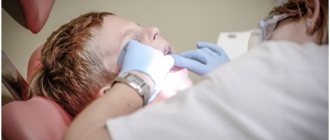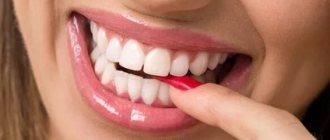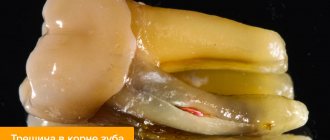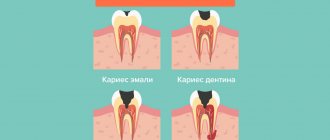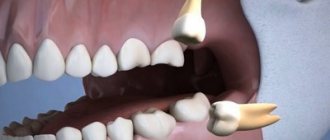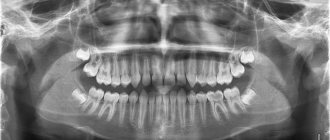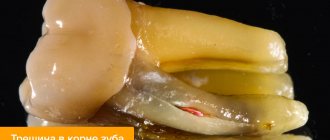Why do ulcers appear on the gums, and is it always dangerous?
There are many possible reasons. To understand how dangerous the appearance of certain lesions on the gums is, you need to look at additional accompanying symptoms:
- in case it is trivial mechanical damage. The gums can be damaged by hard food, a toothbrush, or a foreign object. These lesions may resolve in 3-5 days. If a person does not brush his teeth, then infection is added to these damages, and healing may take several weeks.
- Sometimes ulcers can appear as a result of wearing orthodontic structures, braces or removable dentures.
Classification of dental cracks
- A horizontal crack runs parallel to the gum on the tooth. If the tooth is not treated, the upper part may break off.
- A vertical crack divides the tooth into several parts. If the crack penetrates below the gum, then an infection can penetrate into it, which will cause inflammation of the gums and tooth disease.
- A diagonal crack runs along the tooth surface at an angle. Such cracks cause a part of the tooth to break off. With timely treatment, the tooth can be restored.
- An intradental crack can affect the bone tissue of the jaw, which can lead to tooth loss.
The most common diseases of the oral cavity in which ulcers appear
- ulcerative necrotizing gingivitis. The cause of this disease is bacteria that multiply when immunity decreases. Extensive ulcers appear on the gums, regional lymph nodes become enlarged, and the temperature may rise
- chronic recurrent aphthous stomatitis. Up to 4-5 white spots first appear in the mouth, which later turn into ulcers. There is no temperature or other problems related to well-being. If such symptoms appear 1-2 times a year in small quantities, then there should be no cause for concern. Frequent occurrence is associated with weakened immunity and possible intestinal diseases, as well as allergies.
- acute herpetic stomatitis. Herpetic stomatitis occurs in a child when he first encounters the herpes virus. Many bubbles appear on the gums, which, after bursting, turn into ulcers that merge with each other. The gums are always bright red, and the ulcers themselves are very painful, the temperature may rise
How to tell if a tooth is cracked
When a tooth cracks, patients notice a click. However, it is not always possible to see a crack with the naked eye, and pain often appears later. If a tooth is cracked and puts pressure on the gum, soft tissue swelling occurs and inflammation develops.
Bacteria enter the pulp through destroyed enamel. Patients note increased sensitivity to hot/cold foods and complain of pain when closing their jaws. Bad breath appears in the absence of caries. When chewing, the crack enlarges and, without treatment, leads to a tooth fracture or provokes severe pain due to nerve damage.
Important! A brown or black crack on a tooth indicates that food debris and bacteria have entered deep into the crown. Even damage to the enamel that is not noticeable at first leads to the development of caries.
First aid
If the temperature rises, you can take an antipyretic drug. In the future, before visiting a doctor, nothing should be done. Do not take antibiotics yourself or try to get into the ulcer with any object.
How to relieve symptoms of ulcers
- do not eat sour and salty foods
- food should be warm, no hot dishes or drinks
- Care should be taken to ensure that the child does not put dirty hands in his mouth
- teeth should be brushed, but make sure that the bristles do not touch the gums with ulcers
- It is recommended to rinse your mouth with herbal solutions (oak bark, chamomile) 3-4 times a day
You should be careful when using antibacterial solutions. They must be prescribed by a doctor. If such solutions are used incorrectly, they can provoke the development of thrush. The antibacterial agent will “kill” the beneficial microflora, which can result in a fungal infection.
Prevention of ulcers
- professional oral hygiene at least 2 times a year
- Regularly replacing your toothbrush
- Proper brushing of teeth at least 2 times a day
- using additional hygiene techniques such as irrigators, dental floss, and tongue scrapers
- Children should be monitored for bad habits such as putting dirty fingers and other objects into their mouths
- It is important to treat your teeth in a timely manner. Microbes that are found in carious teeth and rotten roots can serve as a source of infection for ulcers
If you have problems in the oral cavity, contact the specialists of the Center for Family Dentistry!
Why do my gums bleed?
Bleeding from the gums can occur for mechanical or pathological reasons.
The first group includes a blow to the jaw area or minor injuries due to an incorrectly selected crown or filling. In this case, bleeding goes away immediately after the problem is eliminated. Only a doctor can assess whether a crown has been chosen correctly or a filling has been installed during a face-to-face consultation, because it is difficult to see such nuances on your own. Gums can also be damaged by a brush that is too hard, intensive use of dental floss, or careless impact with other objects in an attempt to completely remove food debris. In this case, bleeding appears only after the procedure and disappears after a few minutes.
Pathological causes are associated with diseases of the oral cavity and other organs. Bleeding is a symptom:
- gingivitis - inflammation of the gums;
- stomatitis - ulcers on the oral mucosa;
- periodontitis - inflammation of the soft tissues around the tooth (localized - in several units, or generalized with damage to the entire jaw);
- leukemia (leukemia) - blood cancer with a characteristic decrease in immunity;
- intoxication with heavy metals (lead, mercury);
- diabetes mellitus, which causes weakness of the gums and blood vessels due to characteristic angiopathy.
Often gums bleed due to hormonal changes. It can be caused by pregnancy, menstrual irregularities, and puberty.
When your gums bleed when brushing your teeth
Most patients' gums do not bleed constantly. Symptoms only appear when brushing your teeth or eating hard foods. This occurs for several reasons:
- inflammation of the gums makes them more vulnerable to injury;
- the process of desquamation of the epithelium of the oral mucosa intensifies, which thins the tissue;
- capillaries located close to the gums become more permeable and bleeding occurs more easily.
The combination of all three factors leads to the fact that when brushing your teeth, your gums begin to bleed. This symptom should not be ignored. Cure the disease at an early stage is much faster and cheaper than in an advanced form. And the appearance of blood when brushing your teeth is not considered normal; it is always a sign of pathology.
Fistula on the gum: causes
A fistula on the gum is a hole that forms as a complication after inflammatory pathologies, including untreated ones. It can also occur after dental intervention (poorly provided services). Very often, a fistula is formed as a complication of long-term chronic periodontitis.
Also, the reasons for its appearance may be:
- damage to the tooth root;
- advanced caries;
- pulpitis;
- inflammatory processes of the cyst;
- problems with the growth of wisdom teeth;
- improper teething in children;
- granuloma - inflammatory processes in the tissues of the periosteum and the apical region of the tooth root (accompanied by an increase in temperature, enlarged lymph nodes and other signs).
What is the danger of flux?
This pathology is characterized by the development and further damage to deep periodontal tissues. If left untreated, periostitis takes on the most severe forms and leads to infection of the entire body, which can even lead to death. Therefore, it is important to undergo a preventive dental examination and not delay treatment. The doctor will be able to recognize the pathology in time and take measures to prevent the development of inflammation. This will allow you to save your teeth and avoid various complications that gumboil left unattended can cause.
EXTENSION
There are several ways your dentist can repair a cracked front tooth. A build-up, for example, usually involves applying a composite resin that is a color similar to your real teeth to fill the crack. Compared to other methods of treating a cracked tooth, bonding is one of the least expensive and requires fewer visits to the dentist. Although dental veneers can restore a tooth in just one appointment, the material used is not as durable as others. Because of its fragility, the material - according to the Cleveland Clinic. – more suitable for teeth that do not experience much chewing pressure, such as the front teeth.
Symptoms
Most classified types of cracks can be detected at home by the following signs:
- the tooth begins to ache, although it is difficult to indicate the source of pain;
- severe pain may occur when chewing food;
- Drinking hot or cold drinks can cause discomfort in the area of the cracked tooth.
Restoring tooth enamel
- To restore enamel on a cracked tooth, the enamel is remineralized, coated with a fluoride-containing compound, and a protective coating is applied on top of it. It hardens when exposed to light rays.
- Filling is used for deep damage: chips or trauma to the tooth root.
- Covering with veneers covers a damaged tooth.
- Tooth extension. In case of some damage, for example, if a piece of a tooth breaks off, it can be built up and the previous shape of the tooth restored.
To eliminate the problem of a cracked tooth, you need to contact a dentist as soon as possible, who will determine the type of crack and suggest a way to eliminate it.
Fistula due to root perforation
Working with canals requires the dentist to be careful, attentive, and precise, controlled movements. The slightest carelessness can lead to the formation of a non-physiological hole (perforation), which will subsequently cause inflammation and, as a consequence, the appearance of a fistula.
A common mistake that leads to perforation and inflammation is the fixation of the pin when it is installed not along the canal, but its removal into the bone tissue.
With perforation, treatment of the fistula is the most problematic of all cases of its formation. Moreover, the main difficulty is not in medical procedures, but in the behavior of dentists who do not inform patients about the complication that has arisen, so as not to question the professionalism of themselves and their colleagues. As a result, a person who goes to the hospital for dental treatment returns again due to pain and inflammation: often the process becomes so advanced that it is no longer possible to do anything other than remove the tooth.
But still, perforation is not a death sentence, and the tooth can be saved. The sooner the patient applies, the greater the chance that the treatment will be completed successfully. True, this requires expensive materials (Pro Root MTA is often used), with the help of which the perforation area is sealed. Sometimes filling is performed directly through the canals, sometimes a surgical incision is required to gain visual access to the damaged area.
ROOT CANAL TREATMENT
Some cracks affect not only the surface, but also the inner layers of the tooth. If the crack is deep enough to reach the pulp underneath the enamel and dentin layers, a root canal may be necessary to treat the inflamed pulp and save the tooth. If a root canal is performed to treat a cracked tooth, the dentist will then place a crown on the treated tooth. Although the name of the procedure may sound intimidating, the American Association of Endodontists (AAE) says that the procedure itself is similar to a simple dental filling and is relatively convenient in modern conditions.
IMPLANT INSERTION
According to AAE. A cracked tooth cannot be repaired if the crack extends below the gum line. In this case, the dentist must remove the tooth, but this does not mean that you will be left with a hole in your mouth. An oral surgeon may place an implant in your jaw to replace the root of a tooth. This implant is covered with a crown, making the appearance of the artificial tooth as close as possible to the appearance of real teeth.
It is not so important what method you and your dentist decide to treat the cracked tooth; it is much more important to take care of it afterwards. Brushing twice daily with a fluoride toothpaste such as Colgate Total® will protect the restored tooth from decay. You should also have regular dental checkups to ensure that your tooth augmentation, crown, or implant is in good condition.

